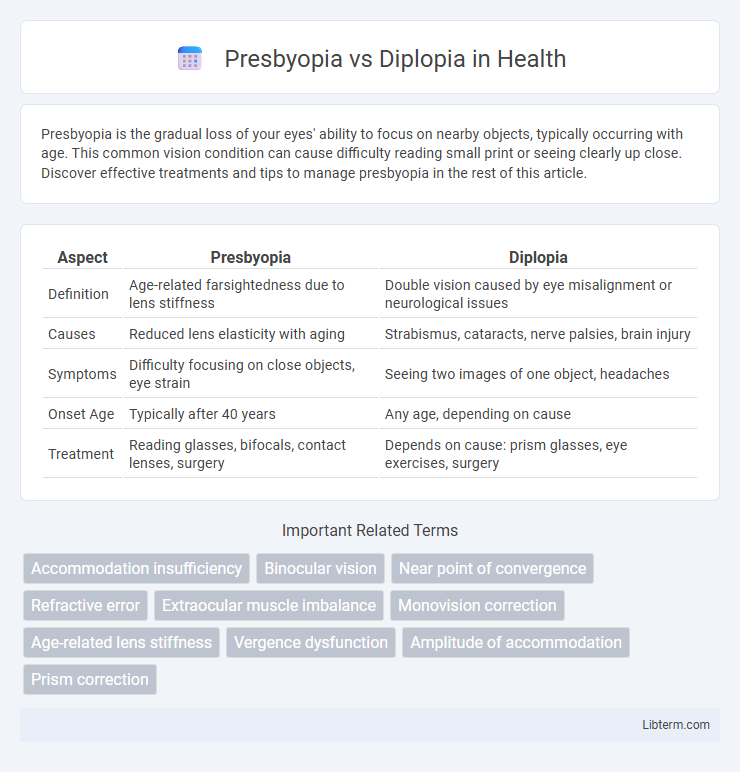Presbyopia is the gradual loss of your eyes' ability to focus on nearby objects, typically occurring with age. This common vision condition can cause difficulty reading small print or seeing clearly up close. Discover effective treatments and tips to manage presbyopia in the rest of this article.
Table of Comparison
| Aspect | Presbyopia | Diplopia |
|---|---|---|
| Definition | Age-related farsightedness due to lens stiffness | Double vision caused by eye misalignment or neurological issues |
| Causes | Reduced lens elasticity with aging | Strabismus, cataracts, nerve palsies, brain injury |
| Symptoms | Difficulty focusing on close objects, eye strain | Seeing two images of one object, headaches |
| Onset Age | Typically after 40 years | Any age, depending on cause |
| Treatment | Reading glasses, bifocals, contact lenses, surgery | Depends on cause: prism glasses, eye exercises, surgery |
Understanding Presbyopia: Causes and Symptoms
Presbyopia is an age-related condition characterized by the gradual loss of the eye's ability to focus on nearby objects due to the hardening of the lens and weakening of the ciliary muscles. Symptoms include blurred vision at close range, eye strain, headaches, and difficulty reading small print, typically emerging after age 40. Unlike diplopia, which involves seeing double images caused by issues in eye alignment or neurological disorders, presbyopia strictly affects near vision clarity.
Diplopia Explained: Types and Underlying Factors
Diplopia, commonly known as double vision, occurs when a person sees two images of a single object, either horizontally, vertically, or diagonally displaced. It is classified into monocular diplopia, caused by issues in one eye such as cataracts or corneal irregularities, and binocular diplopia, resulting from misalignment of the eyes due to nerve palsies, muscle dysfunction, or neurological disorders. Understanding the underlying factors, including cranial nerve damage, orbital trauma, or systemic diseases like diabetes and myasthenia gravis, is critical for accurate diagnosis and targeted treatment.
Presbyopia vs Diplopia: Key Differences
Presbyopia is an age-related condition characterized by the gradual loss of the eye's ability to focus on close objects due to the hardening of the lens, typically affecting individuals over 40. Diplopia, or double vision, involves seeing two images of a single object and can result from various causes such as eye muscle imbalance, neurological disorders, or trauma. The key difference lies in presbyopia affecting near vision clarity due to lens elasticity loss, while diplopia manifests as simultaneous perception of two images typically caused by misalignment or neurological issues.
Age-Related Vision Changes and Their Impact
Presbyopia is an age-related vision condition characterized by the gradual loss of the eye's ability to focus on close objects, typically occurring after age 40 due to the hardening of the lens. Diplopia, or double vision, can result from various causes including eye muscle problems, neurological disorders, or cataracts, and is less directly linked to aging. Understanding the differences between presbyopia and diplopia is essential for diagnosing age-related vision changes and implementing appropriate treatments to maintain visual clarity and quality of life.
Diagnostic Approaches for Presbyopia and Diplopia
Diagnostic approaches for presbyopia primarily involve a comprehensive eye exam including refraction tests to measure the eye's focusing ability, often assessing near vision with reading charts at different distances. Diplopia diagnosis requires a detailed clinical evaluation involving cover-uncover tests to detect eye misalignment, neurological assessments to identify underlying causes, and imaging studies like MRI or CT scans when central nervous system involvement is suspected. Both conditions rely on patient history and symptom description but employ distinct methods tailored to their unique visual impairments.
Treatment Options for Presbyopia
Presbyopia treatment options primarily include corrective eyeglasses such as reading glasses or multifocal lenses, contact lenses including multifocal or monovision lenses, and surgical procedures like LASIK, conductive keratoplasty, or corneal inlays designed to restore near vision. Lifestyle adaptations and the use of magnifying devices may also assist patients in managing presbyopia symptoms. Unlike diplopia, which often requires treatment targeting underlying neurological or muscular causes, presbyopia therapies focus on compensating for the eye's gradual loss of accommodative ability.
Managing and Correcting Diplopia
Managing diplopia primarily involves addressing the underlying cause, which can range from neurological disorders to ocular misalignment. Treatment options include prism glasses to realign the images, vision therapy exercises to improve binocular coordination, and in severe cases, surgical intervention to correct muscle imbalances. Regular consultation with an ophthalmologist or neurologist ensures personalized management plans and effective correction of double vision.
Risk Factors: Who Is More Susceptible?
Presbyopia primarily affects adults over 40 due to age-related hardening of the eye's lens, making this demographic more susceptible to difficulty focusing on close objects. Diplopia, or double vision, can occur at any age and is often linked to neurological disorders, trauma, or eye muscle imbalances, increasing risk in individuals with head injuries, brain tumors, or diabetes. Understanding these distinct risk factors aids in accurate diagnosis and tailored treatment for presbyopia and diplopia patients.
Preventive Measures for Healthy Vision
Presbyopia prevention focuses on regular eye exams and protective eyewear to reduce eye strain and maintain lens flexibility, while managing light exposure and maintaining overall eye health through a balanced diet rich in antioxidants. Diplopia prevention emphasizes addressing underlying causes such as neurological or muscular issues by managing chronic conditions like diabetes and hypertension, alongside wearing corrective lenses and practicing eye exercises to improve muscle coordination. Both conditions benefit from avoiding excessive screen time and practicing the 20-20-20 rule to reduce visual fatigue and preserve long-term vision health.
When to Consult an Eye Specialist
Persistent blurred vision or difficulty focusing on close objects signals the need to consult an eye specialist for presbyopia evaluation. Diplopia, characterized by double vision, requires immediate medical attention, especially if accompanied by headaches, trauma, or neurological symptoms. Early diagnosis by an ophthalmologist or optometrist ensures appropriate treatment options and prevents potential complications.
Presbyopia Infographic

 libterm.com
libterm.com